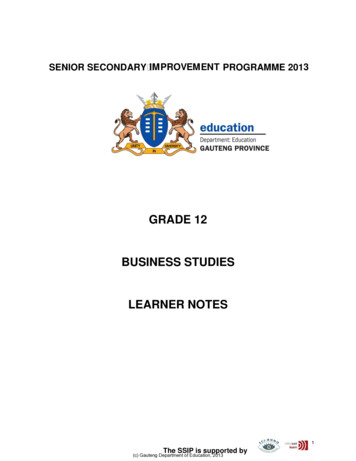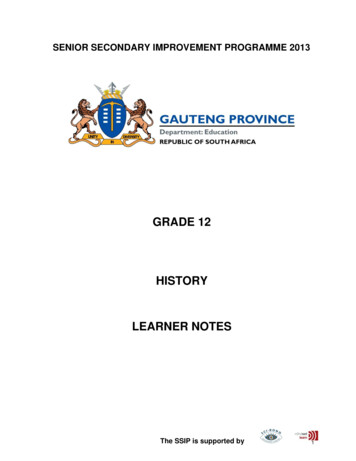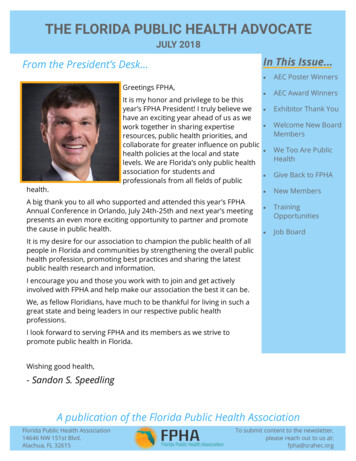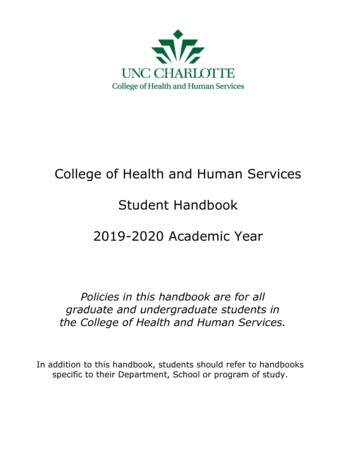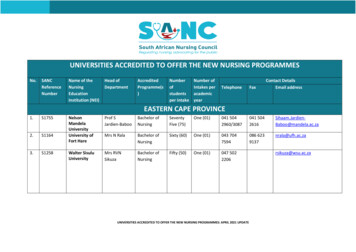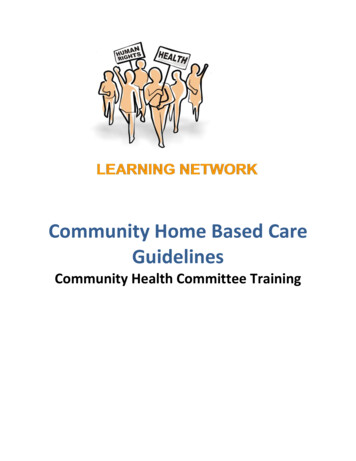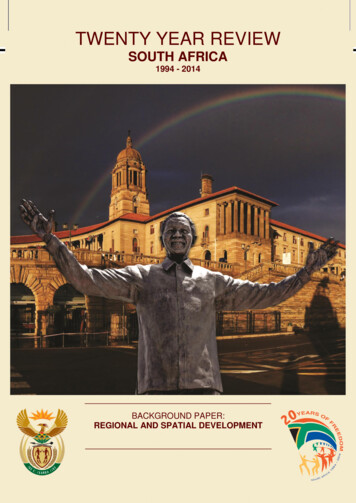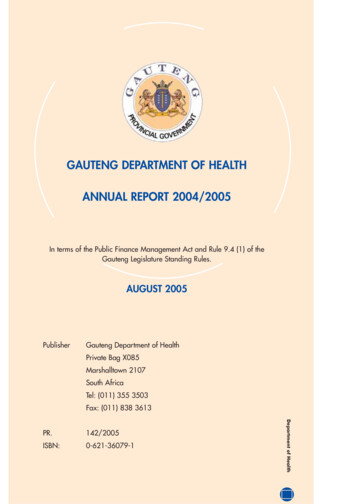
Transcription
GAUTENG DEPARTMENT OF HEALTHANNUAL REPORT 2004/2005In terms of the Public Finance Management Act and Rule 9.4 (1) of theGauteng Legislature Standing Rules.AUGUST 2005PublisherGauteng Department of HealthPrivate Bag X085Marshalltown 2107South AfricaTel: (011) 355 3503Fax: (011) 838 3613142/2005ISBN:0-621-36079-1Department of HealthPR.
Annual Report 2004/2005
ContentsPage115SECTION 2: DEPARTMENTAL OVERVIEW2.1 Organisation of the Department2.2 Constitutional, National and Provincial Legislative Mandates2.3 Good Governance Legislative Responsibilities2.4 Strengthening Accountability99101112SECTION 3: REPORT ON PERFORMANCE IN BUDGET PROGRAMMES3.1 Budget Programme 1: Administration3.2 Budget Programme 2: District Health Services3.3 Budget Programme 3: Emergency Medical Services3.4 Budget Programme 4: Provincial Hospital Services3.5 Budget Programme 5: Academic Hospital Services3.6 Budget Programme 6: Health Sciences and Training3.7 Budget Programme 7: Health Care Support Services3.8 Budget Programme 8: Health Facilities Management171835606268748587SECTION 4: DEPARTMENTAL PERFORMANCE AT A GLANCE93SECTION 5: OUTLOOK FOR THE COMING YEAR99SECTION 6: FINANCIAL REQUIREMENTSReport of the Audit CommitteeReport of the Accounting OfficerReport of the Auditor - GeneralAnnual Financial Statements103103105133141ADDENDUMAddendum A: Medical Supplies DepotAddendum B: Human Resource Oversight ReportAddendum C: National Department of Health Indicators(In terms of National Department of Health and NationalTreasury requirements)Addendum D: Service Excellence Awards, Post ExposureProphylaxis (PEP) and Mandates197197227275291Department of HealthSECTION 1: EXECUTIVE SUMMARY1.1 Foreword by the MEC for Health1.2 Submission of the Annual Report to the ExecutiveAuthority by the Accounting Officer
AcknowledgementsWe acknowledge the inputs of senior managers in the Department, thehospital chief executive officers, managers of other institutions and all ourstaff members for the development and compilation of the annual report.We remain indebted to our key stakeholders and partners in health for theiractive participation in and contribution to improving our health service forthe better. We have no doubt that they will remain committed to improvedhealth outcomes that will change the lives of the most vulnerable in theprovince.Annual Report 2004/2005Special thanks to Sellinah Dumela and the Strategic Support andPerformance Measurement Directorate for coordinating the annual report,Patrick Cockayne for editorial assistance and Niran Singh and the staff ofShereno printers for layout, design and printing of the annual report.
EXECUTIVE SUMMARY AND DEPARTMENTAL OVERVIEWSECTION 1:EXECUTIVE SUMMARY
Section 1: EXECUTIVE SUMMARY1.1 Foreword by the MEC for Health: Dr GM RamokgopaIt is with pleasure that I table the Annual Report of the Gauteng Department of Health forthe financial year 2004/2005. The report reflects on the progress we have made in thefirst year of our third term of democratic government.As this year marks the 50th anniversary of the adoption of the Freedom Charter, thereport will also show the efforts we have made to implement the ideals of the Charterand build a province whose people are healthy, skilled and productive, whosegovernment is caring and responsive to the needs of its citizens and where democracyand citizenship are deepened.When I tabled the Department’s budget vote for 2004/2005, I outlined six strategicpriorities that form the basis of the Five-year Programme of Action that the Departmentwill implement in this term of government. I also made certain commitments to theachievement of targets set for each of the strategic priorities.I promised that in this term of government we would make it easier for communities andindividuals to give us regular feedback, to strengthen performance audits and theaccreditation systems, and to train community health workers.I also promised that we would tackle diseases of poverty and lifestyle, HIV and AIDS andother preventable illnesses, and that we would replace all old ambulances. I furthercommitted the Department to introduce a toll-free patient helpline, to address decisivelythe critical issue of recruitment and retention of staff, to continue to build sustainablerelationships with stakeholders, and to improve the capacity of hospital boards andhealth committees to exercise their oversight role in our facilities.I am pleased to report that good progress has been made in the first year ofimplementing the Programme of Action and that a solid foundation has been laid onwhich we will build incrementally until we have fully met all our goals.Department of HealthThe free primary health care services (PHC) have improved the Gauteng community’saccess to heath care, with an increase of visits from 10.4 million in 2003/2004 to morethan 13 million in the 2004/2005 financial year. We have trained the first 1 000 of aneventual 3 000 community health workers to assist in health promotion, home-basedcare and directly observed treatment support for TB. Close to 80 000 people havealready benefited from this programme.1
Children continue to enjoy our primary focus. The Department’s efforts to improve childhealth have been recognised by the World Health Organisation and the United NationsChildren Fund (WHO/UNICEF). Four additional facilities received the Baby-FriendlyHospital Initiative Awards bringing to eight the number of health facilities accredited thusfar.During the 2004/2005 financial year, 151 457 school learners were screened forobstacles to learning and over 15 000 of these learners were referred appropriately.More than 2 000 learners with visual challenges were given spectacles.The Expanded Programme of Immunisation (EPI) is continuing and the Departmentconducted a mass immunisation campaign in July and August 2004 in line with the goalset by the World Health Organisation for global polio eradication by 2005.Women’s health continues to be one of our priority programmes. In pursuit of our aim ofhelping women to avoid preventable disease and detect diseases early, we performed50 033 pap smears and 9 580 mammograms in the 2004/2005 financial year.Since the inception of the Post Exposure Prophylaxis (PEP) programme, 25 808 clientshave benefited. In response to a low treatment completion rate (30%), we commissioneda study to investigate factors affecting adherence to PEP and we have startedimplementing the recommendations of that study, which we hope will lead to animprovement in the adherence rate.Annual Report 2004/2005TB and HIV and AIDS remain as challenges, placing a heavy burden on the healthsystem. In the year under review, we launched the TB Free Centre, in partnership withSanofi-Aventis and the Nelson Mandela Foundation, to improve training of DOTSsupporters and to achieve greater social mobilisation. The province provided care andtreatment to a total of 38 688 patients, 34 548 (89%) of whom are on Directly ObservedTreatment (DOT) support.2The 2004 HIV sero-prevalence rate amongst pregnant women in Gauteng is 33.1 %, anincrease of 3% over the 2003 figure, and higher than the national prevalence rate of29.6%. In April 2004 we commenced with the implementation of the comprehensive HIVand AIDS care and treatment including ART programme. By the end of the financial yearthe programme was implemented in 23 targeted health facilities and exceeded the targetof 10 000 patients on treatment.The province has managed to treat over 2.5 million patients with chronic diseases in thisfinancial year, an increase of 500 000 from last year. Sight was restored to 8 221people from public and private hospitals in the province.Several large-scale quality improvement projects to improve our infrastructure have
commenced. The Best Practice Programme, which aims to improve relationships betweenhealth care workers and health care users, was piloted at Heidelberg and South RandHospitals with encouraging results. The programme is now being rolled out in Dr.George Mukhari and Natalspruit Hospitals and all the Tshwane clinics.Our complaints system is being used by an increasing number of people as their faith inthe system improves. We received about 800 written complaints in the 2004/2005financial year. The toll free line is now open 24 hours a day, including weekends andpublic holidays. Over 90% of complaints received have been dealt with.The project for training hospital boards was completed in October 2004. Sixty percentof hospital board members were trained.Implementation of our recruitment strategy resulted in the appointment of 5 024 staffmembers, of whom 2 275 are health professionals. For the first time in three years, thenumber of appointments exceeded terminations and this bodes well for our efforts toretain more staff.The Department is making positive strides in the implementation of the EmploymentEquity Act. During the 2004/2005 financial year, we have appointed more women tostrengthen the executive component of corporate services and financial management.Employment of disabled people remains a challenge - their numbers did not change inthe year under review.The implementation of the Employee Assistance Programme (EAP) services through anexternal service provider has resulted in 10 000 (25%) of our staff having access to anEAP with a utilisation rate of 13%.Progress from the Folateng units has also been pleasing. The number of beds forFolateng increased from 95 in 2002/2003 to 184 in 2004/2005. The revenue collectedalso increased from R4.8 million in 2002/2003 to R38 million in the 2004/2005financial year.Department of HealthThe Department invested more than R100 million in medical equipment, including thepurchase of CT scanners for Johannesburg, Helen Joseph, Sebokeng, Coronation andKalafong hospitals.The construction of Hillbrow, Stanza Bopape and Soshanguve Block L Community HealthCentres is nearing completion, while work on building the new Mamelodi Hospital hascommenced. The revitalisation of Chris Hani Baragwanath Hospital proceeded in theyear under review and the construction of the stores was completed and handed over.3
Annual Report 2004/2005The progress outlined above would not have been possible without the support of thePremier, the national Minister of Health, my colleagues in the Executive, the NationalHealth Council, and the Provincial Health Council. I also want to thank the PortfolioCommittees on Heath and Finance, the Head of Department, all managers, staff, tradeunions and our partners who supported our endeavours to make Gauteng a provincewhose people are healthy, skilled and productive.4
1.2 Submission of the Annual Report to the ExecutiveAuthority: Accounting Officer Dr L RispelI hereby submit the Gauteng Department of Health’s Annual Report and AnnualFinancial Statements for the 2004/2005 financial year in my capacity as accountingofficer for the Gauteng Department of Health.The year 2004 saw the nation celebrate the first Decade of Democracy and providedan opportunity to reflect on what had been achieved in these first 10 years. In theGauteng Department of Health, we were able to report on considerable success inaddressing the distortions and injustices of the apartheid era. In particular, we havelaid the legislative and policy framework for a democratic health service serving thewhole population and in particular the poorest and most vulnerable sections of thecommunity, and we have ensured that our staff complement reflects the demographicsof our society. We have also put in place the structures and processes for a healthsystem based on Primary Health Care, while at the same time strengthening the centresof excellence at regional and tertiary hospital levels.As we enter the second decade of democracy there can, however, be no complacencybased on past successes with transformation. The challenges that lie ahead areformidable and include the one posed by the HIV and AIDS epidemic, the increasingburden of chronic diseases and conditions affecting the poorest members of society, thefurther consolidation of the District Health system, and improvements in managementsystems and processes for improved health outcomes and quality of care. More workremains to be done, too, on transformation to achieve increased representation ofwomen and black African professionals in the specialist clinical disciplines.While prevention remains a primary focus in the fight against HIV and AIDS, one ofthe significant achievements was the implementation of the comprehensive prevention,treatment and care programme, including anti-retroviral treatment (ART). Importantly,the targets were exceeded for the number of people on treatment. Gauteng ProvinceDepartment of HealthThis annual report is the first to outline the achievements of the Department in terms ofthe strategic goals and objectives contained in the 2004/2007 Strategic Plan and the2004/2005 Budget Statement that derives from this. It can be seen at a glance thatthe emphasis is squarely on delivery and continuous quality improvement. Our focus onchild and women’s health has seen encouraging results, the details of which arecontained in the annual report. The Department has redoubled its efforts to addresschronic diseases of lifestyle, through both prevention campaigns for stroke, obesity,heart conditions and diabetes.5
took a significant step to prevent and mitigate the impact of the epidemic on provincialgovernment services, by setting up the Employee Assistance Programme (EAP) throughthe Gauteng Shared Service Centre. The Gauteng Department of Health participates inthis innovative programme, and in the next financial year 100% of our staff will becovered.The criticism has often been levelled that, in the balancing act of reconciling needs andresource availability, insufficient money is allocated to infrastructure and equipment.The year under review saw significant investment in purchasing medical equipment,with more than R100 million spent on vital new equipment, including 3 MRI scanners.The new Pretoria Academic Hospital was handed to the Department at the end ofAugust 2004. The bulk of a new fleet of ambulance vehicles has also been delivered inthe various municipalities with the balance due in 2005/2006. Ongoing partnershipswith the private sector have seen the sod turning ceremony for the new Hand SurgeryUnit at Chris Hani Baragwanath Hospital, which will be partly financed by the miningsector.A number of new initiatives, albeit in their infancy, have been put in place across thehealth care system, in line with our Service Improvement Plan. The latter aims to ensurethe widest possible access to care, and that patients enter the health care system at theappropriate level for their needs, and are appropriately referred up or down thesystem.As is the case in any major transformation process, the year saw major challenges thatwe had to grapple with. Natalspruit Hospital was in the eye of the storm, and requiredsignificant investment and intervention from the central office. Strategies to stabilise thehospital included strengthening management, improving systems, filling vacant healthprofessional posts and purchasing equipment. The key lessons we learned from theincident were the need for a dedicated hospital focal point at the central office, and theneed to improve supervision, internal communication and monitoring and evaluation ofour strategic imperatives.AnnualManagement has been strengthened with the filling of key senior posts, including theappointment of black African women to the posts of Corporate Services Manager andChief Finance Officer and the appointment of a woman chief information officer. By theend of the financial year, additional chief director posts had also been created forhospital, district, and information, communication services.Unlike previous financial years, the year under review saw a major under-spending ofthe allocated budget, mainly in capital expenditure. Actions have already been taken
to prevent a recurrence in the next financial year. These include the appointment of anExecutive Support Programme Manager, central management of the equipment budget,improved quality control and monitoring and evaluation.Significant efforts were made to address the matters of emphasis raised by the AuditorGeneral and the Standing Committee for Public Accounts. Staff and managementsupport and action was rallied through four imbizos that focused on implementation ofcorrective measures. In addition, internal task teams were set up to ensure that all assetswere recorded, and these were supported by an outside consultant team. A total of 28person-years in time was spent on fixed asset verification. It is therefore somewhatdisappointing that the corrective measures were insufficient to obtain an unqualifiedaudit report. However, we are encouraged by the unqualified audit report for themedical supplies depot for the second year in succession. Hence, we shall learn fromthe experiences gained from the audit process for the year under review and evaluateour strategies critically towards the achievement of an unqualified audit report.Key departmental initiatives to improve recruitment of health care professionals gotunderway. Eye-catching block adverts were placed to attract more than 1 000 healthprofessionals, including retired nurses. As part of the efforts to retain staff, workcommenced on the revised uniform allowance and on implementation of the EmployeeAssistance Programme. All nursing graduates were guaranteed employment in ourservices, and about 1 000 nursing assistants joined the Department as part of thelearnership and internship programme. The Department has also standardised nursingtraining, in accordance with the Higher Education Act. Nursing colleges have a cooperation agreement with the Johannesburg, Witwatersrand, Limpopo and PretoriaUniversities to ensure implementation of norms and standards for nursing education attertiary level.As we enter year two of implementation of the Strategic Programme of Action, we areable to assess shortfalls against targets set, and redouble our efforts to ensure that theseare met in 2005/2006.Department of HealthMay I take this opportunity to thank the Premier of Gauteng, the MEC for Health, healthmanagers, and the thousands of committed health professionals and support workerstasked with delivering quality health care to the people of Gauteng. On behalf of all ofus, may I thank also those members of the community who work for little or no personalreward to support and strengthen the health services in our province - the volunteerswho carry our health promotion messages into the communities, those who providehome-based care, colleagues from national, provincial and local government,universities, organised labour and non-governmental organisations and the privatesector who contribute in so many ways to our vision - Health for a Better Life.7
Annual
SECTION 2:DEPARTMENTAL OVERVIEW
SUPPLY CHAINMANAGEMENTMr. V. RAMAANOHEALTH ECONOMICSVacantCOST CENTREMr. S.I.W. LINDEQUEINTERNAL CONTROLMr. L.G. NOLTEREVENUE & CONTRACTMANAGEMENTMr. J. MATHIBELAFINANCIALMANAGEMENTMr. G. CROMHOUTFINANCIALBRANCHMr. N. DALEYDIRECTORATE:DISTRICT SERVICESMs. N. MEKGWEMEDICO LEGAL &FORENSIC PATHOLOGYDr R. BROEKMANNDIRECTORATE:METRO SERVICESMs O.L. VOLKWYNTSHWANE/METSWEDING REGIONVacantDIRECTORATE:METRO SERVICESDr S. GAELEJWEJOHANNESBURG /WEST RAND REGIONDr M MAZIZIDISTRICT HEALTHSERVICESMs S SCHNEIDERMEDICAL MANAGERDr. R.N. DLAMINIHIV/ AIDS / TBVacantPUBLIC HEALTHMs. T. CHAANEPUBLIC PRIVATEPARTNERSHIPMr. L.L. BABAFACILITYMANAGEMENTMr. A.G. BARNARDCOMMISSIONINGMANAGEMENTMr. C.J. DANNHAUSERCAPITAL & HEALTHTECHNOLOGY PORTFOLIOVacantPERI PARTUMDR. R.W. MITCHELCLINICAL & SERVICEDEVELOPMENTD.C. MONDZANGAQUALITYASSURANCEDR. S. ARMSTRONGHOSPITAL & SPECIALISEDSERVICESDr. N. DILIZACHIEF DIRECTORATE:HEALTH SERVICESSUPPORTDr. M.O. AHERNDIRECTORATE:DISTRICT SERVICESDr R. LOUWEKURHULENI/SEDIBENG REGIONDr. F.G. BENSONOFFICE OF THE MECMs. H.M. LEBELOANEDIRECTORATE:METRO SERVICESMr. M. MAKHUDUCHIEF OPERATIONSBRANCHDr. A.K.M.M. RAHMANHODDr. L. RISPELMECDr. G.M. RAMOKGOPAHR PROJECTSMr. A.S. TSHABALALALABOUR MANAGEMENTMrs. T.J. MOREINTERGRATED EMPLOYEEWELLNESS PROGRAMMEMrs. M. BORCHERDSHUMAN RESOURCEDEVELOPMENTMs. D.G. JOSEPHHEALTH INFORMMAN & TECHVacantHUMAN RESOURCEMANAGEMENTMr. A. MBALATICHIEF DIRECTORATE:RESOURCE MANAGEMENTMs. M.G. MSIMANGOCOMMUNICATIONS &PUBLIC RELATIONSMr. P. MAJALEGALSERVICESVacantSTRATEGICMANAGEMENTMs S.S. DUMELAINTER DEPARTMENTALAIDS UNITDR. E.K. FLOYDCORPORATESERVICES BRANCHMrs. S.N. NGCOBOApproved Gauteng Department of Health Organisational Structure as at 31 March 2005
SECTION 2: DEPARTMENTAL OVERVIEW2.1Organisation of the DepartmentA new staff establishment in line with service delivery needs has been approved and iscurrently being implemented on the PERSAL system. More Senior Management postshave been created to strengthen the organisation and support to regions, hospitals,clinics and other service delivery institutions.Departmental Structure and FunctionsThe functions of the actors responsible for implementing the mandate and goals of theDepartment during the 2004/2005 financial year are reflected under item 2.4.2. Theorganisational structure as at 31 March 2005 is shown in the diagram indicated on theprevious page.Department of Health9
2.2 Constitutional, National and Provincial Legislative MandatesThe mandate is to improve the health status of the population of Gauteng, improvehealth services and secure better value for money and effective organisation. Thismandate is aligned with the legislative mandate summarised below. The Department receives its mandate from Section 27 of the Constitution. The functions of the Department were governed by the Health Act (63 of 1977), until2 May 2005 when it was replaced by the New National Health Act (61 of 2003)that regulates national health and provides uniformity in respect of health servicesacross the nation. The Public Service Act and all related regulations and prescripts impact on the workof the Department. The Public Finance Management Act (PFMA) promotes improved financialmanagement and ensures increased accountability for public monies spent. The National Health Sector Strategic Framework (Ten Point Plan) informs the workof the Gauteng Department of Health. The Batho Pele principles of consultation, service standards, access, courtesy,information, openness, transparency and redress form the core of social servicedelivery. The Mental Health Act (17 of 2002) ensures provision of care, treatment andrehabilitation with emphasis on community-based services and promotion of rightsfor mental health care users.Annual Report 2004/2005In order to comply with the Department’s legislative mandates, various structures andprogrammes have been put in place over the last ten years. These include: Child health policies and programmesWomen’s health policies and programmesEnvironmental and Occupational health servicesRehabilitation policies and programmesIntegrated Nutrition Programme (INP)District Health ServicesRevitalisation of Hospital ServicesClinical support services policies and programmesEmergency Medical ServicesHIV and AIDS inter-sectoral programmeOther public health policies and programmesMental health care servicesThe national and provincial mandates are implemented at provincial, regional, district10
and institutional levels. The Department has established units that are responsible forcoordination of policy development, implementation and monitoring and developmentof legislation in the Department. These initiatives are aimed at improved public policyformulation and implementation. The detailed Constitutional, national and provinciallegislative mandates are outlined in Addendum D 3.2.3 Good Governance Legislative ResponsibilitiesGood governance in the Department is ensured inter alia, through guidance from, andcompliance with, the following legislation and policies: The Public Service ActThe Public Finance Management ActThe Promotion of Access to Information ActNational Health ActThe Gauteng Hospital Ordinance Amendment ActThe Batho Pele principlesPatients’ Right Charter and the Department of Health pledge of serviceThe Department has established structures and/or mechanisms to ensure accountabilityand participative governance.2.3.1 Inter-governmental StructuresThe MEC for Health continues to chair the quarterly meetings of two political structures:the Provincial Health Authority (PHA) and the EMS Inter-governmental Forum (EMSIGF).Both forums bring together local government councillors responsible for health andemergency services portfolios respectively and officials attend in an ex officio capacity.At a national level, the minister and nine provincial MECs meet on a 6 weekly basis todiscuss sectoral policy and related issues. The MinMEC now called the national healthcouncil is supported by the Public Health Restructuring Committee that consists of thenational director- general for health and the nine provincial heads of health.Department of HealthThe Provincial Health Advisory Committee (PHAC) a technical forum consisting of theHeads of Health in the provincial and local government health departments, meets ona quarterly basis and supports the work of the PHA. A similar forum for the EMS bringstogether officials responsible for emergency health services in provincial and localgovernment. In addition to these structures, the MEC for Health has a monthly rovingmeeting with all municipalities, which involves a formal meeting with the relevant mayorand health councillors, visits to institutions and meetings with stakeholders.11
2.3.2 Community Participation Hospital boards and ward-based health sub-committees enhance communityparticipation in hospitals and primary health care services respectively. The AIDS Council strengthens partnerships with civil society and assists with theleveraging of private sector resources. The Accreditation Committee consists of independent experts who monitor thequality of services in the province and advise the MEC. There is a range of community based activities from mass-based immunisationcampaigns to launch of specific health promotion initiatives in communities. Invitation of stakeholders to the legislature for tabling of the budget and annualreport of the Department. Gauteng Department of Health Imbizos, annual summit and roving meetings inmunicipalities and sub-districts further enhance participation.2.4 Strengthening Accountability to StakeholdersAnnual The implementation of the Public Finance Management Act (PFMA) has facilitatedefficiency gains and improved accountability to different stakeholders. The structures mentioned above have also strengthened accountability. Accountability is further enhanced through regular consultative meetings, thesharing of information through newsletters, and the publication of quarterly andannual reports. Public meetings and specific health promotion events. Annual consultative summits for HIV and AIDS programme, radio messages andcampaigns, annual health and youth summits are mechanisms to strengthenaccountability. Community participation as outlined above.
2.4.1 StakeholdersInternal customersStaff of the Gauteng Department of HealthExternal customersInvolvement of stakeholders in theDepartment’s businessCommunitiesUtilisation and provision of health servicesUtilisation of Patients’ Rights Charter and Service PledgePatients and clientsAs aboveTraditional LeadersPartnerships around strategic priorities e.g. HIV andAIDSStrategic plan, Annual Report oversight functions andquestions etc.LegislatureTreasuryBudget and expenditure management, Budget Statements,quarterly and annual reports, strategic financial support,Bilateral discussions, annual ten by ten meetingAuditor-GeneralAudit of financial statements, performance audits andreportsLocal governmentIntegrated planning, governance structures and servesas agency service providersNational departmentsJoint planning, strategic plan, conditional grants,annual reportsOther Provincial GovernmentdepartmentsSocial Service Cluster and inter-sectoral activitiesMediaMedia releases, media conferences and highlightingachievements and challenges/problemsNon-Governmental Organisations/ Partnership in health service deliveryCommunity Based Organisations andOther strategic partnersPartnership in health service delivery and healthpromotionJoint activities (in some instances)Private sector (general)Provision of external capacity and expertise to deliverhealth servicesProvincial AIDS Council and othergovernance structuresPlanning and monitoring, advocacy, partnerships andcollaborationUniversitiesTraining of health professionals and/or joint staff forservice provision, strategic partnershipsLabour movementConsultative forums, staff representation, participationin strategic and/or joint activities multi-lateralsDepartment of HealthPrivate Health sector13
2.4.2 Functions and Monitoring Mechanisms and Implementation of theMandate by Key ActorsKey ActorsFunctionMECExecutive authority ofthe DepartmentBranch/Chief Monitored eCouncil/LegislaturePolitical accountabilityto the legislature andthe publicStrategic andbudget prioritiesMonthly reportsQuarterlyreportsPolicy directionAnnual reportsAppeals authorityBudget SpeechInter-governmentalcollaborationHead of theDepartment (HOD)The accounting officerof the DepartmentChiefOperationsBranchHead of administrationPerform functions interms of existinglegislationProvides leadership tothe DepartmentAnnual Report 2004/2005Technical advice,support and al/Legislature/TreasuryStrategic Planand BudgetStatements 1,2,3Monthlyfinancial reportsQuarterlyreviews(quarterlyreports)Annual reviews(Annual
SECTION 1: EXECUTIVE SUMMARY 1 1.1 Foreword by the MEC for Health 1 1.2 Submission of the Annual Report to the Executive 5 Authority by the Accounting Officer SECTION 2: DEPARTMENTAL OVERVIEW 9 2.1 Organisation of the Department 9 2.2 Constitutional, National and Provincial Legislative Mandates 10 2.3 Good Governance Legislative Responsibilities 11
